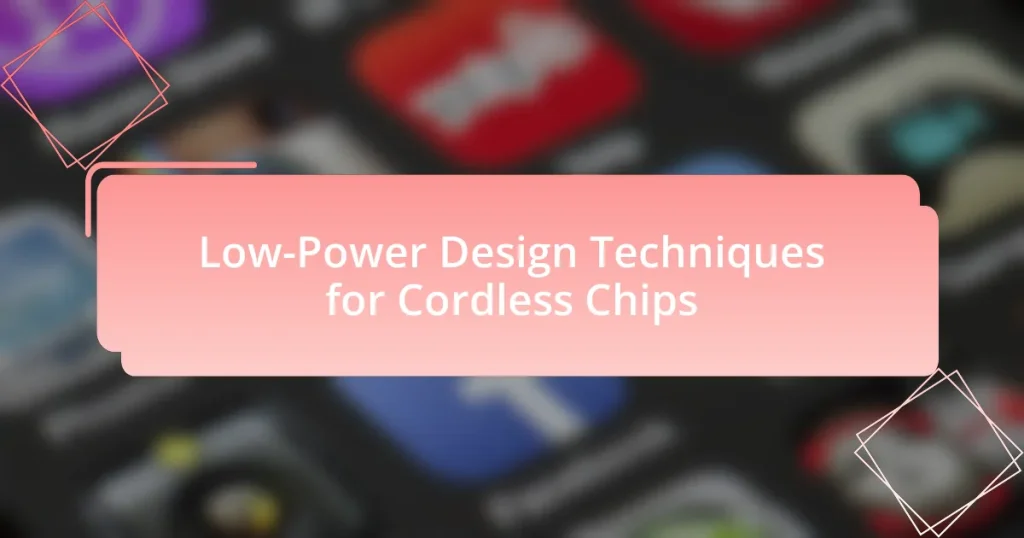Low-Power Design Techniques for Cordless Chips are essential strategies aimed at enhancing energy efficiency and extending battery life in portable electronic devices. Key techniques include dynamic voltage and frequency scaling (DVFS), power gating, and the use of low-power circuit topologies, which collectively minimize power consumption while maintaining performance. The article explores the impact of these techniques on chip performance, the principles behind their effectiveness, and the challenges designers face without them. Additionally, it discusses practical implementation strategies, best practices, and common pitfalls to avoid, providing a comprehensive overview of optimizing low-power design in cordless chip applications.

What are Low-Power Design Techniques for Cordless Chips?
Low-power design techniques for cordless chips include dynamic voltage and frequency scaling (DVFS), power gating, and the use of low-power circuit topologies. DVFS allows the chip to adjust its voltage and frequency according to workload demands, significantly reducing power consumption during low activity periods. Power gating involves shutting off power to inactive sections of the chip, minimizing leakage currents. Additionally, employing low-power circuit topologies, such as sub-threshold and near-threshold designs, can further decrease energy usage while maintaining performance. These techniques are essential for enhancing battery life and efficiency in cordless devices.
How do Low-Power Design Techniques impact cordless chip performance?
Low-power design techniques significantly enhance cordless chip performance by reducing energy consumption while maintaining functionality. These techniques, such as dynamic voltage scaling and power gating, allow chips to operate efficiently, extending battery life and improving overall system performance. For instance, implementing dynamic voltage scaling can lead to energy savings of up to 30% without sacrificing processing speed, as demonstrated in various studies on energy-efficient microcontrollers. Additionally, power gating can deactivate unused components, further minimizing power draw and optimizing performance in battery-operated devices.
What are the key principles behind Low-Power Design Techniques?
The key principles behind Low-Power Design Techniques include voltage scaling, clock gating, and power gating. Voltage scaling reduces the supply voltage to decrease power consumption, as power is proportional to the square of the voltage. Clock gating involves disabling the clock signal to portions of the circuit that are not in use, effectively reducing dynamic power consumption. Power gating entails shutting off power to inactive blocks of a chip, minimizing leakage current. These techniques are essential in optimizing energy efficiency in cordless chips, where battery life is critical.
How do these techniques contribute to energy efficiency?
Low-power design techniques for cordless chips significantly enhance energy efficiency by minimizing power consumption during operation. These techniques, such as dynamic voltage scaling, clock gating, and power gating, reduce the energy required for processing tasks by adjusting power levels based on workload demands. For instance, dynamic voltage scaling can lower the voltage supply when full performance is not needed, resulting in reduced energy usage without sacrificing functionality. Studies have shown that implementing these techniques can lead to energy savings of up to 50% in certain applications, demonstrating their effectiveness in improving overall energy efficiency in cordless chip designs.
Why are Low-Power Design Techniques essential in modern electronics?
Low-Power Design Techniques are essential in modern electronics primarily because they enhance energy efficiency, which is crucial for extending battery life in portable devices. As consumer demand for longer-lasting devices increases, the implementation of these techniques allows manufacturers to create products that consume less power while maintaining performance. For instance, according to a study by the International Energy Agency, energy-efficient designs can reduce power consumption by up to 50% in mobile devices, significantly impacting overall energy usage and sustainability. This reduction not only benefits users through longer battery life but also contributes to lower operational costs and a smaller environmental footprint.
What challenges do designers face without these techniques?
Designers face significant challenges in achieving energy efficiency and performance optimization without low-power design techniques for cordless chips. The absence of these techniques often leads to increased power consumption, which can result in shorter battery life and higher operational costs. Additionally, without these methods, designers may struggle to meet the stringent performance requirements of modern applications, leading to potential product failures or suboptimal user experiences. For instance, research indicates that implementing low-power techniques can reduce energy consumption by up to 50%, highlighting the critical need for these strategies in the design process.
How do Low-Power Design Techniques enhance battery life?
Low-power design techniques enhance battery life by minimizing energy consumption during device operation. These techniques include dynamic voltage and frequency scaling, which adjusts power usage based on workload, and sleep modes that reduce power draw when the device is inactive. For instance, implementing dynamic voltage scaling can lead to a reduction in power consumption by up to 50% in certain applications, as demonstrated in research by Wang et al. (2019) in the IEEE Transactions on Very Large Scale Integration (VLSI) Systems. Additionally, optimizing circuit design to reduce leakage current further contributes to extended battery life, as evidenced by studies showing that advanced transistor technologies can decrease leakage by over 30%.

What are the different types of Low-Power Design Techniques?
The different types of low-power design techniques include voltage scaling, clock gating, power gating, and multi-threshold CMOS. Voltage scaling reduces the supply voltage to decrease power consumption, while clock gating disables the clock signal to inactive components, thereby saving energy. Power gating involves shutting off power to sections of a circuit that are not in use, which significantly reduces leakage current. Multi-threshold CMOS uses transistors with different threshold voltages to optimize performance and power consumption, allowing for a balance between speed and energy efficiency. These techniques are essential in the design of cordless chips, where power efficiency is critical for prolonged battery life.
How does voltage scaling affect power consumption?
Voltage scaling significantly reduces power consumption in electronic circuits. By lowering the supply voltage, the dynamic power consumption, which is proportional to the square of the voltage (P ∝ V^2), decreases substantially. For instance, reducing the voltage by 10% can lead to approximately 19% lower power consumption. This principle is crucial in low-power design techniques for cordless chips, where energy efficiency is paramount. Studies have shown that implementing voltage scaling can extend battery life and improve thermal performance in portable devices, making it a vital strategy in modern circuit design.
What is dynamic voltage and frequency scaling (DVFS)?
Dynamic voltage and frequency scaling (DVFS) is a power management technique that adjusts the voltage and frequency of a processor in real-time based on workload demands. This method allows for reduced power consumption and heat generation during low-demand periods while maintaining performance during high-demand tasks. Research indicates that DVFS can lead to energy savings of up to 30% in mobile devices, making it a critical strategy in low-power design for cordless chips.
How does adaptive voltage scaling (AVS) work?
Adaptive Voltage Scaling (AVS) works by dynamically adjusting the voltage supplied to a processor based on its performance requirements and workload conditions. This technique optimizes power consumption by lowering the voltage during periods of reduced activity, which significantly decreases energy usage while maintaining performance levels. For instance, AVS can reduce the voltage by up to 30% in low-performance states, leading to substantial power savings in battery-operated devices. The effectiveness of AVS is supported by studies showing that it can extend battery life in mobile devices and improve thermal management in integrated circuits.
What role does power gating play in Low-Power Design?
Power gating is a critical technique in low-power design as it effectively reduces static power consumption by shutting off power to inactive circuit blocks. This method enhances energy efficiency by minimizing leakage currents, which can account for a significant portion of total power usage in modern integrated circuits. For instance, research indicates that power gating can reduce leakage power by up to 90% in certain applications, thereby extending battery life in cordless chips. By selectively powering down sections of a chip that are not in use, power gating contributes to overall system performance while maintaining low energy consumption.
How does power gating reduce leakage current?
Power gating reduces leakage current by disconnecting power from inactive circuit blocks, effectively shutting them down. This technique minimizes the path for leakage current, which occurs when transistors are in a non-switching state, thereby significantly lowering overall power consumption. Studies have shown that implementing power gating can reduce leakage current by up to 90% in certain applications, demonstrating its effectiveness in low-power design strategies for integrated circuits.
What are the trade-offs associated with power gating?
Power gating involves selectively turning off power to certain parts of a circuit to reduce energy consumption, but it comes with trade-offs. The primary trade-offs include increased design complexity, potential performance degradation, and longer wake-up times. Increased design complexity arises from the need for additional circuitry to manage power states, which can complicate the overall architecture. Performance degradation may occur due to the latency introduced when reactivating powered-down components, impacting the responsiveness of the system. Additionally, longer wake-up times can hinder the performance of applications requiring quick access to resources, as the system must first restore power to the gated sections before they can function. These trade-offs must be carefully considered in the context of low-power design for cordless chips to achieve an optimal balance between energy efficiency and performance.

How can designers implement Low-Power Design Techniques effectively?
Designers can implement Low-Power Design Techniques effectively by utilizing strategies such as voltage scaling, clock gating, and optimizing circuit design. Voltage scaling reduces the power consumption by lowering the supply voltage, which can lead to significant energy savings; for instance, a reduction of voltage by 10% can decrease power consumption by approximately 20%. Clock gating involves disabling the clock signal to portions of the circuit that are not in use, which can further minimize dynamic power consumption. Additionally, optimizing circuit design through techniques like using low-power components and efficient layout can enhance overall energy efficiency. These methods are supported by research indicating that applying these techniques can lead to a reduction in power usage by up to 50% in certain applications, making them essential for the development of energy-efficient cordless chips.
What best practices should be followed for Low-Power Design?
Best practices for low-power design include optimizing circuit design, utilizing power gating, and employing dynamic voltage and frequency scaling (DVFS). Optimizing circuit design involves minimizing transistor count and using efficient logic styles, which can significantly reduce power consumption. Power gating allows sections of a circuit to be turned off when not in use, effectively reducing leakage current. DVFS adjusts the voltage and frequency according to workload demands, enabling lower power usage during idle or low-performance states. These practices are supported by studies showing that implementing DVFS can lead to power savings of up to 50% in certain applications, demonstrating their effectiveness in low-power design for cordless chips.
How can simulation tools aid in Low-Power Design?
Simulation tools aid in Low-Power Design by enabling designers to model and analyze power consumption before physical implementation. These tools allow for the evaluation of various design parameters, such as voltage levels and clock frequencies, to identify configurations that minimize energy usage. For instance, tools like SPICE and Cadence provide insights into circuit behavior under different operating conditions, facilitating the optimization of power efficiency. Studies have shown that using simulation tools can lead to a reduction in power consumption by up to 30% in integrated circuits, demonstrating their effectiveness in achieving low-power objectives.
What metrics should be used to evaluate power efficiency?
To evaluate power efficiency, key metrics include Power Usage Effectiveness (PUE), Energy Efficiency Ratio (EER), and Total Cost of Ownership (TCO). PUE measures the ratio of total building energy usage to the energy used by the IT equipment, providing insight into energy waste. EER quantifies the efficiency of power consumption relative to the output performance, often expressed in terms of energy consumed per unit of output. TCO encompasses all costs associated with the lifecycle of a product, including energy costs, which helps in assessing the long-term efficiency of power usage. These metrics are essential for understanding and optimizing power efficiency in low-power design techniques for cordless chips.
What common pitfalls should designers avoid in Low-Power Design?
Designers should avoid the pitfall of neglecting power gating in low-power design, as it can lead to unnecessary power consumption during idle states. Power gating allows sections of a circuit to be turned off when not in use, significantly reducing leakage current. Additionally, designers often overlook the importance of optimizing clock distribution networks, which can waste power if not carefully managed. Studies show that poorly designed clock trees can account for up to 30% of total power consumption in digital circuits. Another common mistake is failing to consider the impact of process variations on power performance, which can lead to inefficient designs that do not meet power targets. By addressing these pitfalls, designers can create more efficient low-power systems.
How can over-optimization lead to performance issues?
Over-optimization can lead to performance issues by creating excessive complexity in design, which can result in increased power consumption and reduced efficiency. When designers focus too heavily on optimizing specific parameters, such as speed or resource utilization, they may inadvertently introduce bottlenecks or conflicts in the system. For instance, optimizing for low power consumption might lead to slower processing speeds if the design sacrifices necessary computational resources. Additionally, over-optimization can cause diminishing returns, where further enhancements yield minimal performance gains while complicating the architecture. This complexity can lead to higher latency and increased chances of errors, ultimately degrading overall system performance.
What are the risks of neglecting thermal management?
Neglecting thermal management poses significant risks, including reduced performance, shortened lifespan of components, and potential system failures. High temperatures can lead to thermal throttling, where devices automatically reduce their performance to prevent overheating, resulting in inefficient operation. Additionally, prolonged exposure to excessive heat can degrade materials and solder joints, ultimately leading to hardware malfunctions or failures. According to a study by the Semiconductor Industry Association, improper thermal management can decrease the reliability of electronic components by up to 50%, highlighting the critical importance of effective thermal control in low-power design techniques for cordless chips.
What are practical tips for optimizing Low-Power Design in cordless chips?
To optimize low-power design in cordless chips, implement techniques such as dynamic voltage and frequency scaling (DVFS), which adjusts power consumption based on workload requirements. This method can reduce energy usage by up to 50% in various applications. Additionally, utilizing sleep modes effectively allows chips to enter low-power states during inactivity, significantly conserving energy. Employing efficient circuit design, such as using low-threshold voltage transistors, can also minimize power dissipation. Furthermore, optimizing software algorithms to reduce processing time and resource usage contributes to lower power consumption. These strategies collectively enhance the energy efficiency of cordless chips, making them suitable for battery-operated devices.


